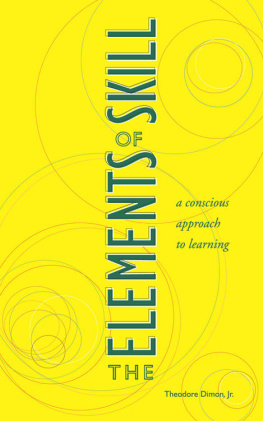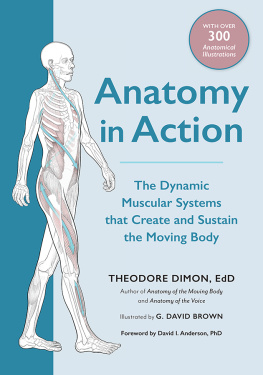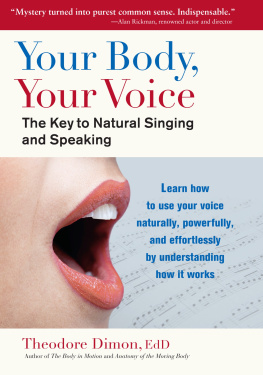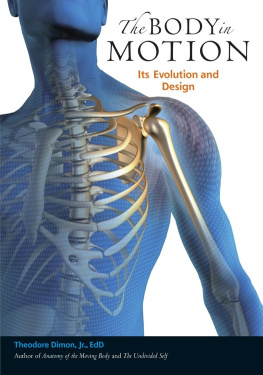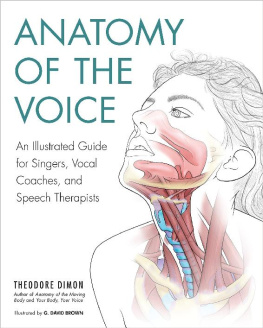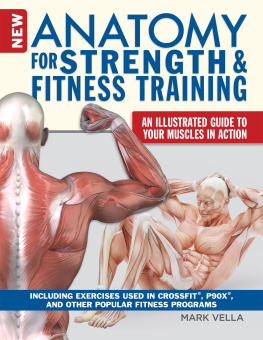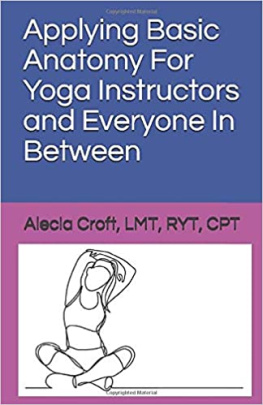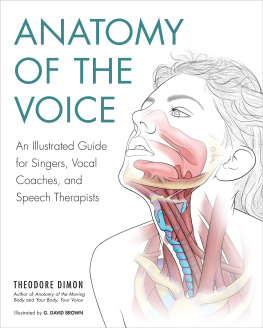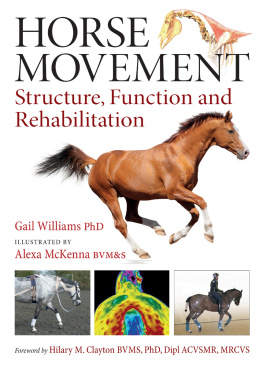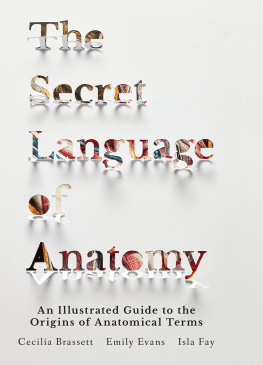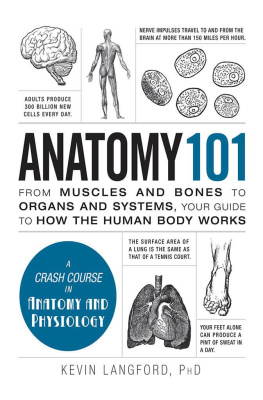Copyright 2001, 2008 by Theodore Dimon, Jr. All rights reserved. No portion of this book, except for brief review, may be reproduced, stored in a retrieval system, or transmitted, in any form or by any meanselectronic, mechanical, photocopying, recording or otherwisewithout the written permission of the publisher. For information contact North Atlantic Books.
Published by North Atlantic Books
P.O. Box 12327
Berkeley, California 94712
Cover by Brad Greene
Anatomy of the Moving Body is sponsored by the Society for the Study of Native Arts and Sciences, a nonprofit educational corporation whose goals are to develop an educational and cross-cultural perspective linking various scientific, social, and artistic fields; to nurture a holistic view of the arts, sciences, humanities, and healing; and to publish and distribute literature on the relationship of mind, body, and nature.
North Atlantic Books publications are available through most bookstores. For further information, call 800-733-3000 or visit our website at www.northatlanticbooks.com.
The Library of Congress has cataloged the printed edition as follows: Dimon, Theodore.
Anatomy of the moving body : a basic course in bones, muscles, and joints / Theodore Dimon, Jr.; with illustrations by John Qualter. 2nd ed.
p. cm.
Summary: Presents information on muscles, bones, and joints. Intended for dancers, movement educators, and therapistsProvided by publisher.
eISBN: 978-1-58394-687-9
1. Musculoskeletal systemAnatomy. 2. Human locomotion. 3. Alexander technique. I. Qualter, John. II. Title.
QM100.D56 2008
611.7dc22
2008008586
v3.1
Other books by Theodore Dimon, Jr.
THE BODY IN MOTION:
Its Evolution and Design
ELEMENTS OF SKILL:
A Conscious Approach to Learning
THE UNDIVIDED SELF:
Alexander Technique and the Control of Stress
YOUR BODY, YOUR VOICE:
The Key to Natural Singing and Speaking
To my grandfather,
PANOS DIMON,
with unbounded love

Table of Contents
Illustrations
Anatomical planes
Anatomical directions
The skull
The base of the skull
Flexors and extensors attaching to base of skull
Muscles supporting hyoid bone and larynx
Base of the skull and muscles of the throat
Muscles and joint of jaw
Muscles of facial expression
Muscles of the jaw
Suspensory muscles of the larynx
Suspensory muscles of the larynx (cont.)
The tongue
Muscles on the floor of mouth
Muscles of palate
Muscles of the throat
The pharynx
The larynx
Intrinsic muscles of the larynx
Anterior muscles of cervical spine
The vertebrae and spine
Atlas and axis (C1 and C2)
The skull and head/neck joints
Ligaments of the spine
Lower spine showing pinched disc
Back muscles: 1st layer (transversospinalis muscles)
Back muscles: 1st layer (cont.)
The sub-occipital muscles
Back muscles: 2nd layer (sacrospinalis or erector spinae)
Back muscles: 3rd layer
Back muscles: 4th layer
Back muscles: 5th (superficial) layer
Muscles attaching to the front of the spine
The rib cage
The costovertebral joints
Ribs during exhalation and inhalation
The intercostal muscles
Transversus thoracis
The diaphragm
The abdominal muscles
Rectus abdominis muscle
The scalene muscles
Suspensory muscles of the thorax
Muscles of the thorax (cont.)
Joints of shoulder girdle
Scapula and shoulder joint
Trapezius, teres major, and latissimus dorsi
Scapula muscles
Serratus anterior and pectoral muscles
The rotator cuff muscles
The deltoid muscle
Flexors of the arm
Triceps brachii muscle
Bones of elbow and forearm
Supinators and pronators of the forearm
Bones of wrist and hand
Joints of the wrist
Joints of the thumb
Extensors and flexors of wrist
Flexors of digits
Extensors of digits
Intrinsic muscles of the thumb
Intrinsic muscles of the little finger
Interossei and lumbricals
The pelvis, the right innominate bone
Landmarks of the pelvis
The hip joint and femur
Ligaments of the pelvis
Ligaments of the hip joint
The iliopsoas muscle
The deep muscles of the hip
The gluteals
The adductors
Muscles of the thigh
The quadriceps muscles
The hamstring muscles
The knee joint
Bones of lower leg
The ankle joint
Ligaments of the ankle
Bones of foot
Joints of the foot
Anterior muscles of the leg
Lateral muscles of the leg (peroneal muscles)
Muscles on the back of the leg
Muscles on the back of the leg (cont.)
Intrinsic extensors of the foot
Interossei muscles
Intrinsic muscles of the little toe
Intrinsic muscles of the big toe
Intrinsic flexors of the toes
Arches of the foot
Preface to the New Edition
Although this book was originally conceived as a set of lectures complemented by simple line drawings, this new edition features highly detailed and graphic three-dimensional illustrations, making it a far more complete reference than the first edition. Based on an accurate digital model of the musculoskeletal system, the muscle and bone images are now more clearly shown and presented from the most advantageous angle.
I would like to thank John Qualter, co-founder of Biodigital Systems, for supporting this project and for his vision and patience in putting together a digital model of the entire human anatomy. I would like to thank Lauren Edgar and John Reusch at Biodigital Systems for their excellent work in creating the illustrations, many of which had to be modeled from scratch.
I would also like to thank Darryl Lajeunesse and CD Media Studio for creating the elegant and detailed digital musculoskeletal model that served as the foundation for this project.
Thanks to Sarah Serafimidis of North Atlantic Books for her work on the earlier edition of this book and for her input on the new one. Finally, thanks to project editors Hisae Matsuda and Jessica Sevey, art director, Paula Morrison at North Atlantic Books, and to Brad Greene, designer of the new edition.
Preface
This book was originally written as a series of lectures for a basic course in anatomy given at the Dimon Institute for the Alexander Technique in New York City. Its purpose is to provide teachers and students of movement with a basic text covering all the muscles, bones, and joints relating to movement. More specifically, it is designed for movement educators who are putting together their own courses on anatomy and require a basic manual to work from that provides, not just drawings and names of anatomical structures, but written lectures which tie this material together into a coherent series of presentations. The lectures also provide sufficient explanation to enable the book to serve as a self-help manual for students of movement and dance.
The overwhelming consideration in putting together this bookand the feature, I think, that distinguishes it from many others on the subjecthas been simplicity and clarity of presentation. Anatomy as a subject matter has developed in close association with medical science; as such, anatomical texts tend to be highly technical and detailed, and often seem designed more to intimidate and impress than to enlighten. For many, such books not only fail to convey the necessary and relevant information about anatomy as it pertains to movement; they also contain much that is irrelevant and unnecessary to such study. In the process of giving too much detail, they also fail to explain how muscles and bones work in simple terms, and so further obfuscate the real issue for students and teachers of movement, which is not merely to know, but to understand.


